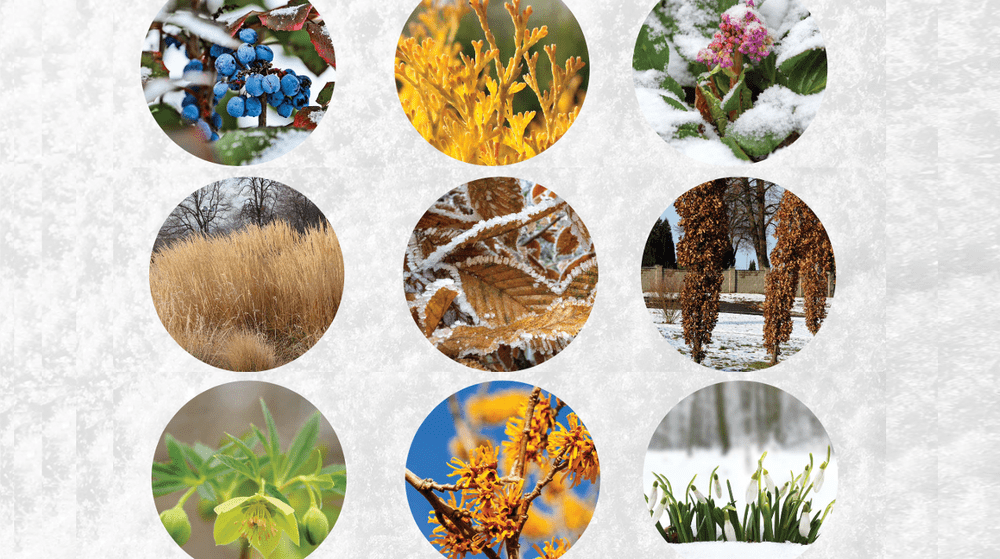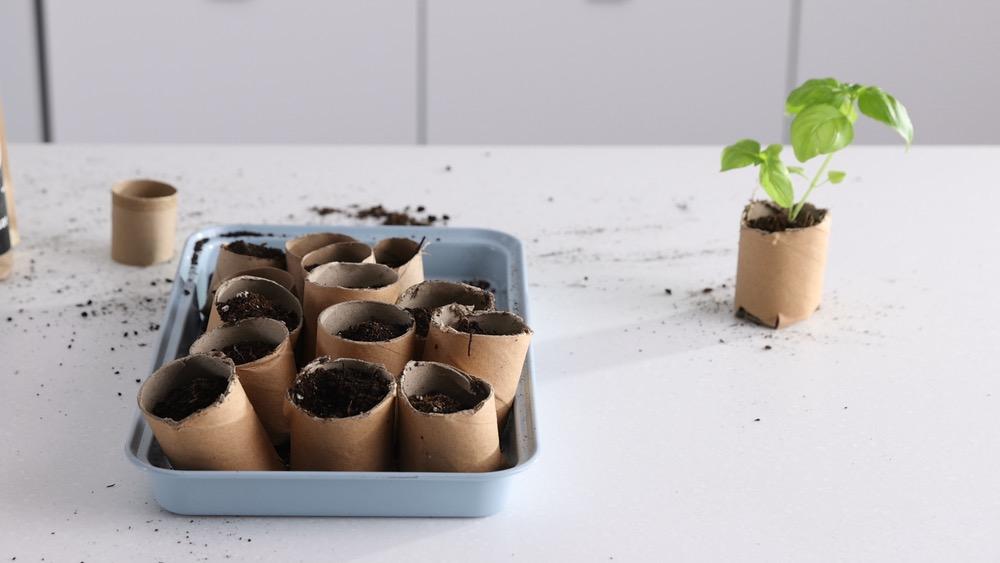Winter is the best time to plan and update your garden. Study your space and mark the places where structural plants, berried shrubs and early bloomers would be welcome next winter. Here are nine superstar plants to consider.

Oregon Grape Holly (Mahonia aquifolium)
This is one of my favourite shrubs almost every time of year. I used to think I loved the Oregon Grape Holly best in spring with its fuzzy golden and fragrant yellow flowers or even in the summer when the yellow flowers (that the bees love) turn into blue grape-like berries that feed the birds. But, lately, it’s been outshining most of the other plants in my winter garden with its glossy dark-green-to-deep-burgundy foliage that stays on through winter. This broad-leaf evergreen (meaning it keeps its leaves through winter and sheds them in spring) usually grows 3-6 feet tall and 2-4 feet wide.
More reasons to love Oregon Grape Holly: It is deer resistant, loves part to full shade and is easy to grow.

Amber Gold Cedar (Thuja occidentalis ‘Jantar’)
This evergreen has stunning yellowy chartreuse foliage that turns an amber-gold in the cold, so it will really shine in a winter garden. It’s a multi-stemmed upright (pyramidal) evergreen that can grow to 15 feet tall and holds a beautiful shape, so it’s fine to be planted on its own or in multiples for a dramatic effect. Like all Arborvitaes, it needs moist, well-drained soil and protection from drying winds.
Best Evergreens for Your Garden
How to Attract the Most Desirable Winter Birds

Bergenia (B. cordifolia)
When everything else seems to have withered away in winter, it gives me great pleasure to see the beautiful dark glossy leaves of my Bergenia plants poking through the snow. It’s a small perennial that grows 12-18 inches tall and about the same wide, so to really enjoy it in the winter, it’s best placed next to a well-used pathway or showy raised bed.
Many gardeners also select this plant for its gorgeous pink deer-resistant flowers that last for weeks during the spring. It prefers moist, well-drained soil and can tolerate full sun but thrives in a partly sunny location.

Calamagrostis x acutiflora ‘Karl Foerster’
This fast-growing and sturdy grass looks spectacular through summer and fall and holds its shape very well through the winter. In 2001, this perennial, also known as Feather Reed Grass, won the Perennial Plant of the Year Award and it has been a darling in the garden ever since.
It can grow to about 6 feet high and stays in clumps about 2 feet wide, which makes it a great bang for your buck in a perennial border and a meadow garden and probably why it’s used (I would say “misused”) often in commercial landscapes.
Here’s HOW to use Calamagrostis ‘Karl Foerster’ in a landscape: Plant multiple clumps in a mixed planting with stunning native plants like black-eyed Susan (Rudbeckia hirta), butterfly milkweed (Asclepias tuberosa), cardinal flowers (Lobelia cardinalis), goldenrod (Solidago), rose mallow (Hibiscus moscheutos), wild bergamot (Monarda fistulosa), Joe Pye weed (Eutrochium maculatum), tall meadow rue (Thalictrum dasycarpum), New England asters (Symphyotrichum novae-angliae) and more.
Note: Wait until late spring to cut it back, as its tubular stems are a favourite overwintering hiding place for beneficial insects like ladybugs and native bees.

Columnar European Hornbeam (Carpinus betulus ‘Columnaris’)
This shapely dense tree grows like a living column, providing structure and form to the garden in all seasons.
I love all hornbeams, including the spreading varieties, but I find the columnar trees the most striking in the garden because they can form a living wall to help define a space, add privacy or, best of all, give us something to admire in the winter. You should know that they are pretty slow growing and can reach up to 35 feet tall and 10 feet wide at maturity. This is a tree you plant for multiple generations to enjoy, as it can live well over 100 years if it’s in full to part sun with moist, well-drained soil.

Pyramidal English Oak (Quercus robur ‘Fastigiata’)
This beautiful narrow tree has a strong central branch that makes it look like a living column. It is often planted in formal gardens or used as hedging but I like to incorporate these trees somewhere they can be seen from a house window. They have year-round interest with textured bark and leaves that, once established, stay on during the winter — which means it’s a favourite gathering place for birds and beneficial insects. In the summer, it has dark, glossy green leaves and requires full sun. It can grow as high as 50 feet and up to 10 feet wide and, if it’s in the right spot, will survive for generations.
If you need more reasons why you should plant any shape and variety of oak trees, check out this article in the New York Times.

Christmas Rose (Helleborus)
This cold-weather-loving perennial blooms for weeks (at Christmastime on the West Coast, early March in central Ontario) and maintains glossy leaves throughout the winter which hold their structure through the snow. If you have seen Hellebores growing and you have a party-shady, moist garden, you probably have multiples of this plant like I do because they are so fabulous. They grow and spread about 12 inches and look great in multiples and by a pathway where they can be admired daily.
Hellebores are most commonly found with white or lime-green blossoms, so when you see them in dark burgundy, with white and crimson polka dots, and even in black, they will take your breath away (and cost you a pretty penny).

Chinese Witch Hazel (Hamamelis Mollis)
Chinese Witch Hazel is a fragrant and showy winter flowering shrub that can bloom anytime between December and April, depending on what hardiness zone you live in and how cold the winter temperatures get (the warmer your weather, the earlier your shrubs will bloom). When planted in the front yard, passersby will stop and take photos — or open their plant i.d. app — because it’s so unusual looking. The flowers remind me of tassels and bloom in clusters on leafless branches. If the weather stays cool, the blossoms can last for more than 4 weeks. As the temperatures get warmer, the flower’s scent becomes sweeter.
Ready to plant a Hamamelis Mollis? Plan for it to grow about 10-15 feet high and spread like a “V” shape from the bottom. It can take full sun and part shade and should have well-drained soil. Once it’s established, it’s very low-maintenance and even deer resistant.
One last and important note: As much as I love this plant in the late winter/early spring, it’s even better in the fall. The medium-sized boring green leaves that grow through summer turn into multi-coloured rainbows in the fall — red, orange, yellow and green — and then they are pure golden yellow before falling off with the first frost.
Top 16 Native Plants for Your Garden

Snowdrops (Galanthus)
Snowdrops are early-blooming bulbs with delicate-looking white flowers that look spectacular planted in large masses.
The flower bulbs are tiny and must be planted in late summer or early fall. As the name suggests, snowdrops are one of the first flowers to bloom, either in the winter or very early in the spring, depending on where you live — either way, they are usually first admired when their blossoms are poking through a thin layer of snow.
In the garden, snowdrops are easy to care for. They require moist, well-drained soil and a bright spot. They will multiply and naturalize if left in an undisturbed area. After they bloom, allow the leaves to stay in place and wither away — that will enable them to store the energy they need for next year.
Jennifer Reynolds, our previous Editor-in-Chief, is a long-time authority in gardening, do-it-yourself projects, urban sustainability, parenting, placemaking and community matters. Her features and columns have been published in Canadian Living, Canadian Family, Gardening Life, House & Home, Globe & Mail, National Post, Toronto Star & more. Plus, her designs and expertise have been featured on dozens of HGTV, W Network and CTV shows.













